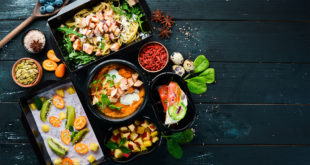 In a restaurant, especially a newly started or taken over one, it is highly recommended you get to know the other area food facilities and develop good relationships with them. While this may seem quaint, sort of like moving into a new neighborhood and making nice with the neighbors, there is a very good reason for doing this.
In a restaurant, especially a newly started or taken over one, it is highly recommended you get to know the other area food facilities and develop good relationships with them. While this may seem quaint, sort of like moving into a new neighborhood and making nice with the neighbors, there is a very good reason for doing this.
Yes, technically, other area restaurants are competition, but they can also be allies and assets. Similar to a bed and breakfast being full and recommending another one in the area when they are fully booked and it’s in turn reciprocated. This can also happen in restaurants. Each restaurant unless they have the exact same menu as you, the same prices, the same décor and clones of all your staff, is unique to itself.
The primary reason for being buds with your neighboring restaurants is because in a pinch, they may have stock of something you are out of. While this may seem purely mercenary to think about this in advance, it’s not. Most restaurants in business today that have been around for awhile, have a relationship with at least one if not more restaurants in a fairly close proximity, or they have a key food vendor who will go the extra mile for them and track down things at 11 at night for them.
Whether it’s the owners being friends or the chefs, cooks or bartenders, it’s important to be civil to the neighbors. Easy ways to do this may be stopping in for dinner occasionally or an after hours drink and meet everyone in charge. If owners/chefs/key employees stop in your place, buy them a drink, get them some free apps.
Being prepared for this eventuality (of being out of something) may seem overkill and not on an important to do list, but more often then not a key ingredient of your most popular menu item goes out of stock on a Holiday weekend or that caterered party you are doing for 50 people is suddenly increased by 40 people the day before and you can’t get product in the door in time for it. While this may not happen often, and if your management team is a well organized one, it will dramatically decrease the odds of it happening, but it is still best to plan for every eventuality.
When many restaurants run out of product, they send someone to the local grocery to get a replacement instead of running out completely. Doing this will totally kill your food cost. Not to mention many retail products don’t have the same quality as wholesale. Borrowing for a neighboring restaurant who may have paid $0.40 more a pound for Statler chicken breasts instead of buying at retail for 4 times what you paid for it originally, saves you time and money in the short and long term. Buying retail can also affect cash flow in house and result in confusion at the end of the night, when the cash-out doesn’t match up (i.e. the cook or busboy forgot to return and log the receipt from going to a grocery), not to mention headaches for your accountant. Cash for paying for retail items comes directly out of petty cash usually, more cash-out mistakes and petty theft as well can result from this.
In 20 years in the business I have lost count of the number of times other restaurants have bailed me out and in turn I have bailed them out. There are some things you just cannot plan for, no matter how well organized and anal you are about your inventory. The 30 person buffet that wants poached salmon: your normally trusted fish vendor either out of stocks you or on the very off chance you get a bad batch of fish, which was specifically ordered to cover the buffet and you sent it back because it was poor quality. What was the option, take in bad fish and have your customers get sick and/or your reputation go in the toilet? When dealing with perishables there is only some much extra you can keep on hand at any one time.
While you may have a stock in of salmon in this instance (say you run it regularly and it’s a hot item on the menu) do you run that salmon (that you have in house for your party) and 86 it on the menu and have some unhappy customers in your dining room? Run down to your local Stop & Shop, buy salmon for twice the price that has already had twice the day run shelf life? The alternative is borrow from a local that you know has good product and replace it at the first opportunity. You want happy satisfied customers all around.
There are caveats to this:
* Keep careful track of what has been borrowed from whom and make sure product when re-supplied is the same quantity and most importantly the same brand if possible.
* When items are borrowed, especially meat and fish products and most importantly shellfish, keep very very careful records of this, if items were contaminated prior to the borrowee’s restaurant getting hold of it, it needs to be trackable. Most borrower/borrowee relationships buy from many of the same vendors but not all.
* Don’t borrow from others that have bad quality control, if your chef wouldn’t have let it in the door in the first place from a vendor, it’s not something you want either.
* Don’t abuse the area relationships, running out of Maraschino cherries every Friday night tends to get old very fast to the borrowee. (not to mention annoying to regular customers)
* Be wary of the habitual borrowers in return (see above)
 Corner Booth Blog | TundraFMP Restaurant Supply, News & Equipment Blog
Corner Booth Blog | TundraFMP Restaurant Supply, News & Equipment Blog



